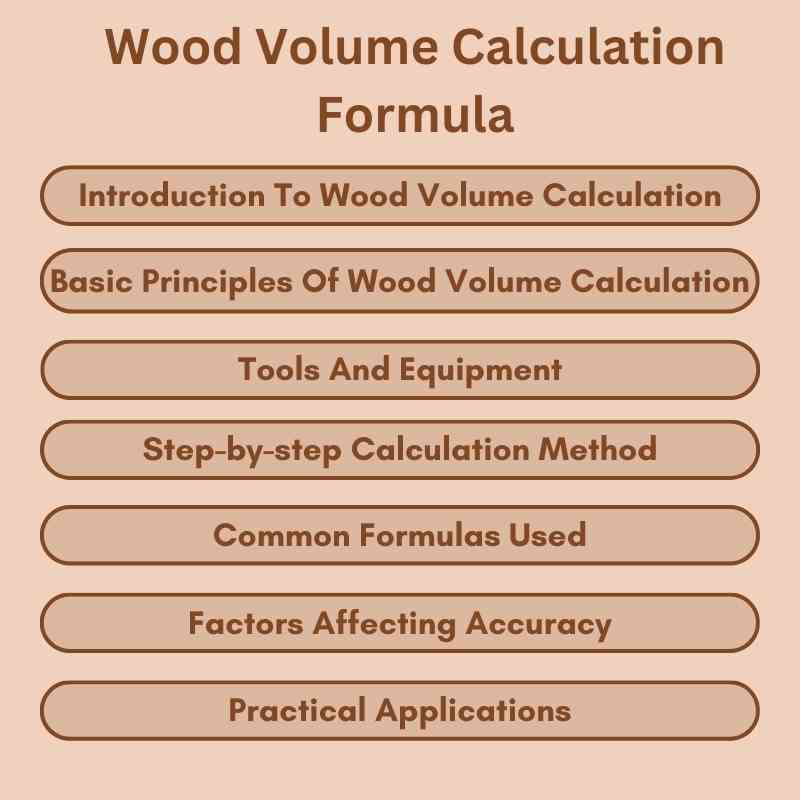The wood volume calculation formula involves measuring length, width, and height, then multiplying these dimensions. The result is expressed in cubic units.
Calculating wood volume is essential in various fields like construction, forestry, and woodworking. Accurate measurements help in estimating costs, planning projects, and ensuring efficient use of resources. Understanding how to calculate wood volume can save time and prevent material wastage.
This formula is especially useful for professionals and hobbyists alike. By mastering this simple calculation, you can make informed decisions and optimize your work. Whether you’re building furniture or managing a forest, knowing the wood volume is crucial for success.
Introduction To Wood Volume Calculation
Accurate measurements ensure you get the right amount of wood. They help in fair pricing and avoid disputes. Precise data is also key for planning projects. Correct measurements prevent waste and save money.
Timber measurement can be tricky. Uneven shapes make it hard to measure. Moisture content can change wood size. Human error is another big issue. Tools may not always be accurate. Different methods can give different results.

Basic Principles Of Wood Volume Calculation
Wood volume calculation is simple. Measure the length, width, and height of the wood. Use a ruler or tape measure for this. Each dimension is important. Write down each measurement.
Multiply these three numbers together. This gives the volume. For example, if the length is 2 meters, width is 1 meter, and height is 0.5 meters, the volume is 1 cubic meter.
Always use the same units. If you measure in meters, keep all measurements in meters. Mixing units can cause errors. Common units are meters, centimeters, and feet. Convert measurements if needed.
For large pieces, use cubic meters. For small pieces, use cubic centimeters. Understanding the right units is key. This ensures accurate calculations.
Tools And Equipment
Wood volume calculation formulas help determine the amount of wood in a given log or timber. Accurate measurements ensure efficient resource management and cost estimation. Proper tools and equipment make the process simpler and more precise.
Measuring Instruments
Measuring wood volume needs accurate tools. Use a tape measure to get length, width, and height. Calipers help measure small pieces of wood. A ruler can be handy for shorter pieces. Use a scale for weighing wood, which helps in some calculations. Proper tools ensure correct measurements.
Digital Tools
Laser distance meters are very precise. They measure long distances quickly. Digital calipers show exact readings, which are easy to read. Wood volume calculator apps help with quick calculations. 3D scanners can measure complex shapes. Data loggers record measurements for future use. Digital tools save time and increase accuracy.
Step-by-step Calculation Method
First, measure the length of the wood. Use a tape measure for accuracy. Next, measure the width of the wood. Ensure the tape measure is straight. Finally, measure the height of the wood. Write down all measurements. Ensure all measurements are in the same unit. This is important for accurate calculations.
Use the formula Volume = Length × Width × Height. Multiply the length by the width. Then, multiply the result by the height. This gives the volume in cubic units. For example, if length is 2 meters, width is 0.5 meters, and height is 1 meter, the volume is 2 × 0.5 × 1 = 1 cubic meter. This formula works for all regular shapes of wood.
Common Formulas Used
To find the volume of rectangular timber, use the formula: Volume = Length x Width x Height.
Measure the length, width, and height in meters for the best results.
Multiply these three dimensions together.
This formula works well for simple shapes.
For cylindrical logs, the formula changes. Use Volume = π x (Radius2) x Height.
First, measure the radius of the log’s base.
Then, measure the height of the log.
Square the radius and multiply by π (approximately 3.14159).
Multiply this result by the height to get the volume.
Factors Affecting Accuracy
Wood volume calculation accuracy depends on factors such as measurement precision, wood density variations, and the formula used. Proper calibration and consistent methods enhance reliability.
Moisture Content
The moisture content of wood can change its volume. Wood with high moisture is heavier. It can also shrink when dried. Dry wood gives more accurate measurements. Always measure the moisture level first. Use a moisture meter for best results.
Wood Type And Density
Different wood types have different densities. Hardwoods are denser than softwoods. Dense wood weighs more for the same volume. Light wood can give false volume readings. Knowing the wood type helps in accurate calculation. Check wood species before measuring.
Practical Applications
Calculating wood volume accurately aids in efficient lumber production and resource management. This formula helps in determining material needs for construction projects.
Forestry And Logging
Calculating wood volume helps in managing forests. It helps to know the amount of wood available. This ensures sustainable logging. Loggers can estimate profits accurately. It also helps in planning future harvests. Accurate calculations prevent overharvesting.
Woodworking And Carpentry
In woodworking, knowing the wood volume is crucial. Carpenters can plan their projects better. It helps in buying the right amount of wood. This saves money and reduces waste. Accurate measurements ensure the quality of the final product. Knowing the volume is important for pricing custom pieces.
Tips And Best Practices
Calibrate your tools regularly for accurate measurements. Accurate tools ensure precise wood volume calculations. Use a reliable calibration method for consistency. Check your tools before every major project. Regular checks prevent errors in measurements. Calibration tools are available online and in stores.
Double-check all measurements to avoid mistakes. Measure twice to be sure. Write down your measurements immediately. Accurate records help in double-checking. Use a second tool to verify measurements. Consistency between tools confirms accuracy. Double-checking saves time and resources.

Frequently Asked Questions
How To Calculate Volume Of Wood?
To calculate wood volume, measure length, width, and height in feet. Multiply these values together. For cylindrical logs, use the formula πr²h, where r is radius and h is height.
What Is The Formula For Calculating Cubic Feet Of Wood?
To calculate cubic feet of wood, use the formula: length (ft) x width (ft) x height (ft). Measure in feet for accuracy.
What Is The Formula In Calculating The Volume Of A Lumber?
The formula to calculate the volume of lumber is: Volume = Length x Width x Thickness. Ensure all measurements are in the same units.
How To Calculate Timber Volume?
To calculate timber volume, measure the length, width, and height in meters. Multiply these dimensions together to get cubic meters. Use the formula: Volume = Length x Width x Height.
Conclusion
Mastering the wood volume calculation formula is essential for efficient project planning. This guide simplifies the process, making it accessible. Accurate measurements save time and resources. Use these tips to enhance your woodworking projects. Stay precise and enjoy the benefits of proper calculations.
Happy woodworking!

